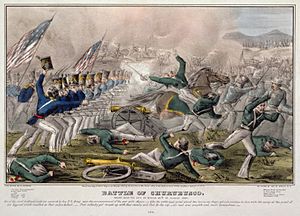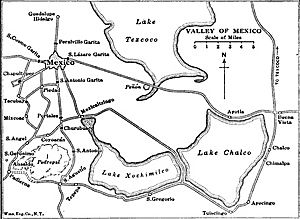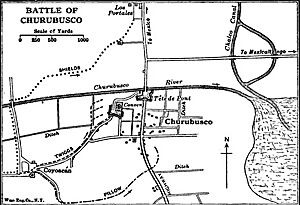Battle of Churubusco facts for kids
Quick facts for kids Battle of Churubusco |
|||||||
|---|---|---|---|---|---|---|---|
| Part of the Mexican–American War | |||||||
 Battle of Churubusco, J. Cameron, published by Nathaniel Currier |
|||||||
|
|||||||
| Belligerents | |||||||
| Commanders and leaders | |||||||
| Strength | |||||||
| 8,497 | 1,400 | ||||||
| Casualties and losses | |||||||
| 139 killed 865 wounded 40 missing |
263 killed 460 wounded 20 missing. 1,261 captured |
||||||
The Battle of Churubusco happened on August 20, 1847. It was part of the Mexican–American War. This battle took place while the Mexican army, led by Santa Anna, was retreating. They had just lost the Battle of Contreras.
A special group called the San Patricio Battalion fought in this battle. This group was mostly made up of soldiers who had left the U.S. Army. They made their final stand here against the U.S. forces. The U.S. Army won the battle. They had more than twice as many soldiers as the Mexican defenders. After this victory, the U.S. Army was only about 5 miles (8 km) away from Mexico City. Later, 50 members of the San Patricio Battalion were officially executed by the U.S. Army. This was the largest mass execution in U.S. history.
Contents
What Happened Before the Battle?
After losing battles at Contreras, General Antonio López de Santa Anna told his troops to move back. He ordered Major General Nicolás Bravo Rueda to retreat from San Antonio to Churubusco. Santa Anna also told Major General Manuel Rincón to defend a place called the Franciscan Convent of San Mateo in Churubusco. This convent had strong defenses and seven cannons.
General Francisco Pérez was placed at a special bridge defense, called a tête de pont, on the south side of the river. Two regiments of soldiers were placed along the river. Inside the convent were the Bravo Battalions and the San Patricio Battalion. Santa Anna also kept a group of reserve soldiers ready along the main road to the north.
The Battle Begins
General Winfield Scott of the U.S. Army sent two of his groups, led by David Twiggs and Gideon Johnson Pillow, towards Coyoacán. He also ordered William Jenkins Worth to attack the Mexican position at San Antonio. Worth sent Colonel Newman S. Clarke's group and Lieutenant Colonel Charles Ferguson Smith's Light Battalion across a rocky area to the west of San Antonio. Meanwhile, Colonel John Garland faced San Antonio from the south.
As the Mexican defenders were leaving San Antonio, Clarke's Brigade attacked them from the side. Garland's group then moved forward. They captured a Mexican General and four cannons as the Mexicans pulled back from San Antonio.
The Fight at the Convent
General Scott then ordered an attack on the convent. The convent had strong stone walls. The Mexican soldiers had also started digging trenches to help defend it. Some extra soldiers arrived to help, from the Tlapa and Lagos Battalions. They placed three cannons on the right, two in the middle, and two on the left.
The Independencia group was told to defend the upper walls of the convent. They also guarded the right side leading to the bridge and the parts of the convent that were not fortified. The Bravos and the San Patricios were positioned on the left side, behind barricades. The Pérez Brigade, with 2,500 men, supported them along the Churubusco River.
Worth's division attacked the bridge defense (the tête de pont). Twiggs's division attacked the convent itself. The Mexican gunners at the convent were good, and they forced one of the U.S. cannon groups to pull back. General Perez's defense at the bridge also stopped two attacks by the U.S. 6th Infantry.
Another U.S. attack, led by Franklin Pierce and James Shields, tried to cross the river to cut off the Mexican retreat. This attack was also stopped. However, Worth's troops managed to go around the Mexican left side and cross the river. The U.S. 8th and 5th Infantry then captured the bridge defense. After this, Captain Duncan set up cannons to attack the convent.
Inside the convent, two of the Mexican cannons had become too hot and melted. A third cannon had fallen from its stand. Lieutenant Colonel Francisco Peñúñuri led a small group of men in a charge with bayonets, but they were defeated. He died in the battle. Officers from the Bravos tried to raise a white flag to surrender three times. But members of the San Patricios stopped them. The San Patricios wanted to fight until the very end and not let the Americans capture their flag. In the end, the San Patricio Battalion was captured. Their leader, John Patrick Riley, and others were later put on trial for leaving the U.S. Army. U.S. Captain James Milton Smith finally stopped the fighting by waving a white handkerchief.
What Happened After the Battle?
The Americans captured many prisoners and cannons. At the bridge defense, they took 192 prisoners and three cannons. At the convent, they captured 1,259 prisoners, including three Generals and the San Patricios leader, Lieutenant Colonel Francisco Rosenda Moreno. They also took seven cannons there. Further down the road, they captured another 380 prisoners.
General Winfield Scott estimated that the Mexican army had about 4,297 soldiers killed or wounded in the battles of Contreras and Churubusco. They also had 2,637 soldiers taken prisoner.
Seventy-two men from the San Patricios Battalion were put on trial by the U.S. Army for leaving their posts. Two separate trials were held. Fifty of them were sentenced to be hanged because they had left the army after the war had officially started. Those who had left earlier received 50 lashes. (You can find more details about them in the Saint Patrick's Battalion article.)
When General Twiggs asked the Mexican General Anaya to give up his ammunition after the battle, Anaya famously replied, "If I had any ammunition, you would not be here."
General Scott decided not to chase the Mexican army directly into Mexico City. He said he wanted to "leave something to this republic." So, he stopped his victorious army at the city gates. A group of volunteer soldiers from New York stayed at the convent until September 7.
Gallery
In Popular Culture
Parts of this battle were shown in the 1985 ABC mini-series North and South. This show was based on a series of novels by John Jakes. The battle also appeared in the 1999 film One Man's Hero.
See also
 In Spanish: Batalla de Churubusco para niños
In Spanish: Batalla de Churubusco para niños







